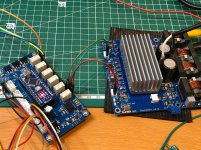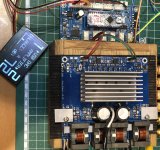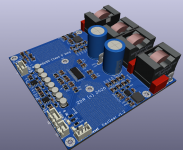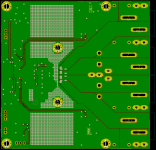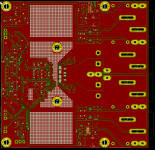I was tempted to redesign the board to use LM5017, but now having second thoughts since everything works so well with LT3012. It cannot really handle voltages above 30V without heatsink, but that is not a problem for me since I never intended using this at 160W per channel. The idea was to have a good sounding amp for room listening levels that can compete with best of A/B class.
Attachments
Last edited:
Good job! Replace please MLCC in input))
Haha, of course, they are there only temporarily. I have to admit though, I did hear anything bad coming out of them, so not sure if it’s a myth or reality.
I could do that since I have another 12V running into preamp, but that would then create a ground loop and increase THD+N tenfold.
Yes. I tried different ways of suppressing ground loop, but I could not eliminate it completely. When I separate PS for preamp and power amp, it's gone completely.
Never mind, enough power to go around with 24V.
Never mind, enough power to go around with 24V.
Even if you use an isolated supply? For example, two-prong 9 VAC transformer wall-wart into basic power supply (ideally active rectifier 🙂), completely isolated from ground.I could do that since I have another 12V running into preamp, but that would then create a ground loop and increase THD+N tenfold.
Even a chassis-mount transformer should still work though since you wouldn't be connecting any additional ground references.
I need also 5V for opamp section. That would be too many external power supplies for a small amp I was planning to design 🙂
I managed to blow yet another IC, I am now pretty sure there is no short circuit protection for internal regulator inside TPA3255. Each time I blew it by drawing too much current from VDD pins, one way or another.
Before latest incident, I tried 100uF MLCC input caps, it was enough current draw to blow it on second power up. Replaced the IC, and everything back up again.
If someone wants to play with this amp, I have boards available for as low as 5 eur each. It works great until 30V, even 40V with; for me, even with low efficiency speakers, more than enough power. Who needs power ranges with >0.1%THD anyway?
I managed to blow yet another IC, I am now pretty sure there is no short circuit protection for internal regulator inside TPA3255. Each time I blew it by drawing too much current from VDD pins, one way or another.
Before latest incident, I tried 100uF MLCC input caps, it was enough current draw to blow it on second power up. Replaced the IC, and everything back up again.
If someone wants to play with this amp, I have boards available for as low as 5 eur each. It works great until 30V, even 40V with; for me, even with low efficiency speakers, more than enough power. Who needs power ranges with >0.1%THD anyway?
I am pretty sure I have seen diyAudio plans for multi-voltage power supply boards... let me see if I can dig something up.
Ah, here we are: Linear Audio Silent Switcher V3 – diyAudio Store
Ah, here we are: Linear Audio Silent Switcher V3 – diyAudio Store
I am pretty sure I have seen diyAudio plans for multi-voltage power supply boards... let me see if I can dig something up.
Ah, here we are: Linear Audio Silent Switcher V3 – diyAudio Store
Thank you🙂
This amp definitely deserves and update, so here it is🙂
Two LM5017 for 5 and 12V, should run much colder. Optimized space for original TPA heatsink
Two LM5017 for 5 and 12V, should run much colder. Optimized space for original TPA heatsink
Attachments
Last edited:
ZDR what are the differences between each of the 3 boards? The Green and Red look different.
I'd like to see the socket 8 pin for the OPAMPS.
4 layer PCB with isolated improved circuits path for better cooling less noise?
I love the clear area for many heat sink options.
I'd like to see the socket 8 pin for the OPAMPS.
4 layer PCB with isolated improved circuits path for better cooling less noise?
I love the clear area for many heat sink options.
ZDR what is max voltage input rating? It's marked 50 on the what you shared. Can it do 53-56 MAX like Ti design?
Does it have full feature set of Ti original TPA3255?
Does it have full feature set of Ti original TPA3255?
Red is the top layer, green is bottom. Moving to four layer would be unnecessary and a lot more expensive. I guess I could put the place for opamp socket, but that would compromise the distances around the Soic variant. Best amps are nowadays not available in dip flavor.
- Home
- Amplifiers
- Class D
- Compact TPA3255 design with PFFB and single PS

